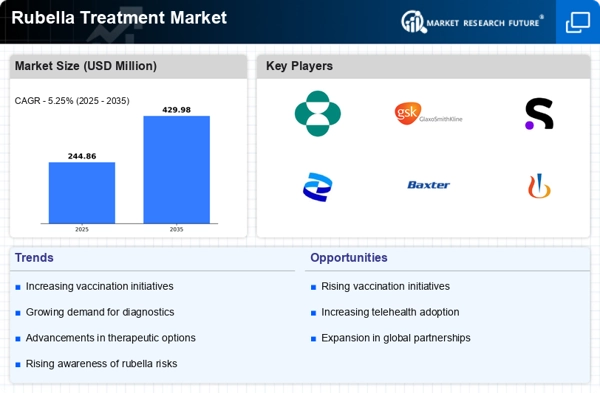The Rubella Treatment Market is characterized by a competitive landscape that is increasingly shaped by innovation, strategic partnerships, and regional expansion. Key players such as Merck & Co. (US), GlaxoSmithKline (GB), and Sanofi (FR) are actively engaged in enhancing their market positions through various strategic initiatives. Merck & Co. (US) has focused on expanding its vaccine portfolio, emphasizing research and development to improve efficacy and safety profiles. Meanwhile, GlaxoSmithKline (GB) appears to be leveraging its extensive distribution networks to enhance accessibility in emerging markets, thereby broadening its consumer base. Sanofi (FR) is also investing in digital transformation, aiming to streamline operations and improve patient engagement through technology-driven solutions. Collectively, these strategies contribute to a dynamic competitive environment, where innovation and accessibility are paramount.
In terms of business tactics, companies are increasingly localizing manufacturing to reduce costs and enhance supply chain efficiency. This approach not only mitigates risks associated with global supply chain disruptions but also aligns with regional regulatory requirements. The Rubella Treatment Market is moderately fragmented, with several key players exerting influence over their respective segments. The collective actions of these companies indicate a trend towards consolidation, as they seek to enhance their competitive edge through strategic collaborations and mergers.
In August 2025, Merck & Co. (US) announced a partnership with a leading biotechnology firm to co-develop a next-generation rubella vaccine. This collaboration is significant as it not only enhances Merck's research capabilities but also positions the company to respond more effectively to emerging health threats. The partnership is expected to accelerate the development timeline, potentially leading to a market launch that could reshape the competitive landscape.
In July 2025, GlaxoSmithKline (GB) launched a new initiative aimed at increasing vaccine awareness and accessibility in underserved regions. This initiative is crucial as it addresses the disparities in vaccination rates, particularly in low-income countries. By focusing on education and outreach, GlaxoSmithKline is likely to strengthen its brand loyalty and market share, while also contributing to global health objectives.
In September 2025, Sanofi (FR) unveiled a digital health platform designed to facilitate patient engagement and streamline vaccination processes. This strategic move reflects a growing trend towards digitalization in healthcare, where technology plays a pivotal role in enhancing patient experiences. By integrating digital solutions, Sanofi is positioning itself as a forward-thinking leader in the Rubella Treatment Market, potentially setting new standards for patient interaction and care.
As of October 2025, the competitive trends in the Rubella Treatment Market are increasingly defined by digitalization, sustainability, and the integration of artificial intelligence. Strategic alliances are becoming more prevalent, as companies recognize the value of collaboration in driving innovation and improving operational efficiencies. Looking ahead, competitive differentiation is likely to evolve from traditional price-based competition to a focus on technological advancements, innovative solutions, and reliable supply chains. This shift underscores the importance of adaptability and foresight in navigating the complexities of the healthcare landscape.

















Leave a Comment